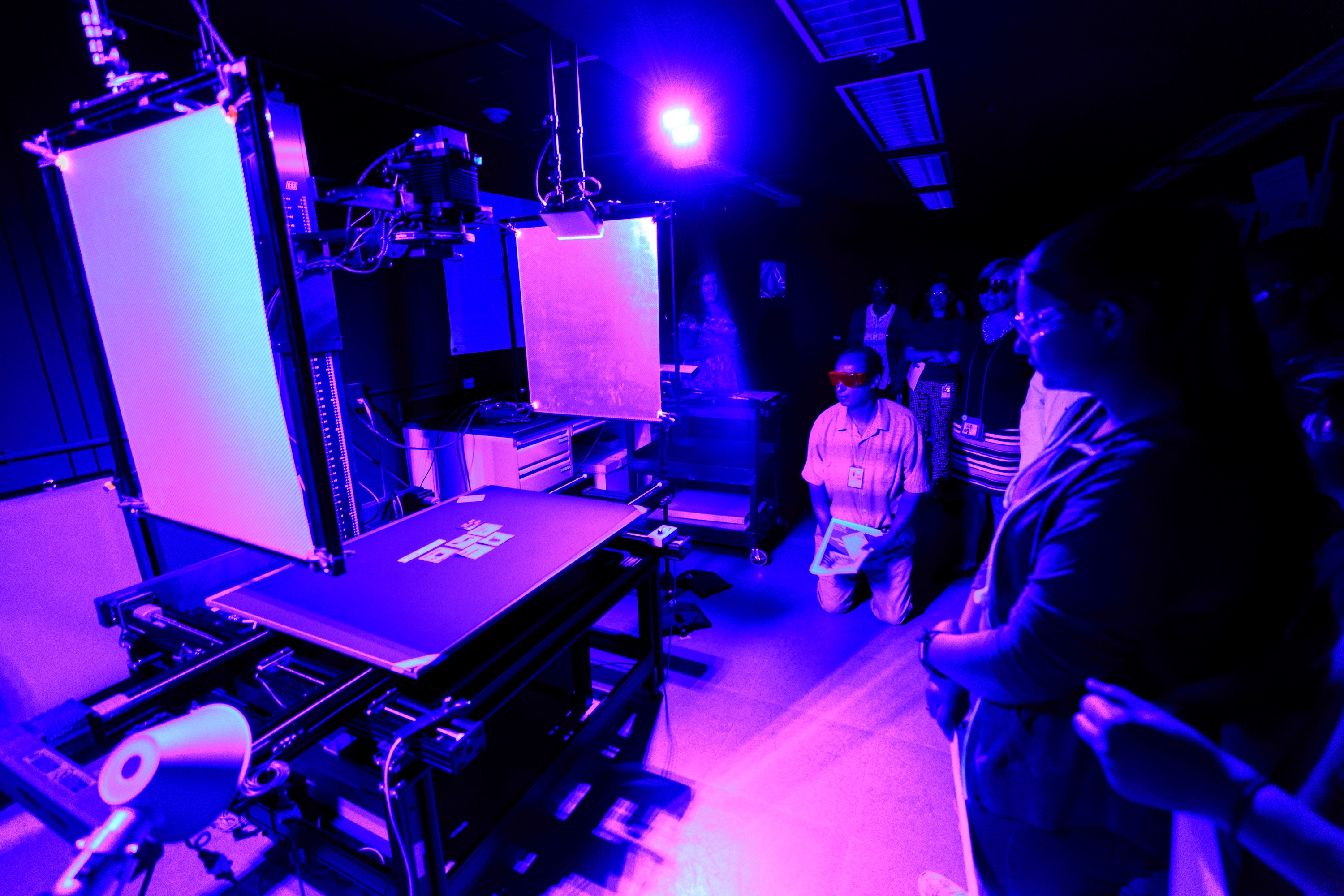Middle and high school students conduct hands-on testing with multispectral photographic analysis with preservation science staff. 2018 photo by Shawn Miller.
Not long ago, Steve Rogers was coming unglued. The red-white-and-blue-bedecked superhero who knocks Adolf Hitler off his feet in the No. 1 issue of “Captain America” needed help himself this time.
The Library’s copy of this valuable comic – it can sell for $300,000 or more – had several tears and cracks that required an adhesive. Library conservators had a new product in mind, but they wanted to make sure it would not change or damage the paper.
So they turned to the Preservation Research and Testing Division. Tests conducted in the division’s labs confirmed the treatment could safely keep intact the iconic captain’s adventures, and the Marvel universe was saved once more.
That project comes to mind during Preservation Week, an annual observation by the American Library Association to call attention the billions of items in the care of the nation’s cultural institutions. Many of them are in a perilous state, like the copy of “Captain America” the Library holds, and require delicate care.
This particular week, the Library’s work in scientific literacy has become critical in the face of COVID-19. The Preservation Division’s staff – including six Ph.D. scientists — are participating in a multi-institutional study to determine how libraries and museums can safely resume services. The study, carried out by federal and private partners, will review the scientific literature and conduct tests to address the needs of cultural heritage institutions.
“The division is focused, at a fundamental level, on understanding if we’re doing the work of preservation the best way it possibly can be done,” says Jacob Nadal, the division’s director. “It’s essential that the Library and the international community have this kind of scientific attention focused on new preservation methods and new approaches to treatment.”
Fenella France, chief of the division, has a background in textile science. Others have backgrounds in engineering, chemistry, physics, fine arts, forensics, and musical composition. One of the division’s fellows is a medieval studies scholar turned data scientist.
“Everyone has a slightly different eye for things,” France says.

Some of the Preservation Division at work on a text. (L-R) Jamie Shetzline, a chemist; Fenella France, division chief; Alex Gillespie (University of Toronto), and Tana Villafana, chemist. Photo: Chris Bolser.
Some of the resulting methods have influenced not only the way conservators treat artifacts, but how people understand them.
France once used multispectral imaging – which can determine the composition of inks and pigments, track changes in documents over time and reveal faded or crossed-out writing — to examine the Library’s draft copy of the Declaration of Independence. She discovered that Thomas Jefferson initially wrote “subjects” in the document, then carefully rewrote “citizens” over it.
“I often call it document archaeology,” she says.
The staff has also rescued sound recordings from disintegrating discs, tested the way collection items respond to public exhibition, developed specialized storage environments and determined the chemical composition of an array of material.
The division traces its birth to a 1970 grant of $70,000 from what is now known as the Council on Library and Information Resources. At the time, the Library was spending more than $500,000 a year to preserve brittle books, manuscripts, newspapers and other items. It couldn’t keep up.
The hope was that the grant would help develop new approaches to handling deteriorating material and developing best practices for remediation. This information would then benefit libraries nationwide.
The effort got a boost when the Library acquired the William J. Barrow collection. A Virginia businessman and a self-trained chemist, Barrow had collected more than 1,000 books dating from 1507 to 1899. He conducted scientific studies on them using destructive techniques. He employed a machine to fold pages until they broke. He cut out pieces and tested their pH level. It all helped lead to a process to de-acidify paper.
The Preservation division continues to test Barrow’s books and maintains a major focus on research to benefit the nation’s libraries. They are now directing a project funded by the Andrew W. Mellon Foundation to evaluate the condition of books in research libraries nationwide.
Of course, it’s not all about paper. CDs, DVDs, magnetic tape, fibers and fabrics are now tested with an array of sophisticated technology. Size-exclusion chromatography is used to examine the molecular weight of a paper’s cellulose; if a paper has a lower average molecular weight, it’s more degraded. The test requires only micro-punches of paper, one millimeter in diameter.
Among noninvasive tests, X-ray fluorescence elicits data about chemicals and elements in an artifact. Infrared spectroscopy provides information about organic materials. Fiber optic reflectance spectrometry offers details about pigments.
These endeavors, Nadal says, underline “how preservation science supports the scholarly purpose of the Library, by enabling fundamental knowledge of materials to inform the way people interpret those materials.”
Subscribe to the blog— it’s free! — and the largest library in world history will send cool stories straight to your inbox.















